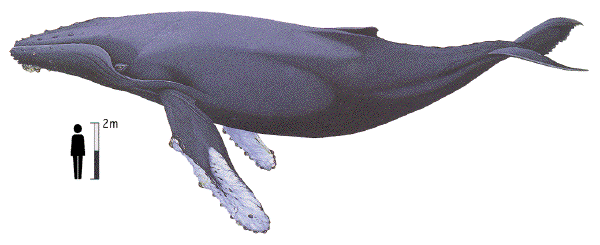The Humpback Whale
(Megaptera novaeangliae)
The Humpback whale is one of the most energetic of the rorquals. It is known for its spectacular breaching, flipper-slapping and lobtailing. It is easily identified at close range by its knobbly head and long flippers. The black and white colouration on the underside of the flukes (tail) allows scientists to distinguish and name individuals all around the world. No two Humpback whales are exactly alike.
During breeding season the Humpback males are known for singing the longest and most complex songs in the animal kingdom. Humpbacks are highly inquisitive and will approach quite closely, showing little fear of boats.
The Humpback whale has a more robust body than other rorqual. It's back and flanks are grey or black with an area of white on the throat and belly. It has a slender head which constitutes up to one-third of its total body length. The top of the head is flattened and covered by a number of fleshy knobs or tubercles. Unlike other rorquals the midline ridge on the top of the Humpback's head is indistinct. The lower jaw has a rounded protuberance near the tip and is covered with similar tubercles to those on the head. Baleen plates numbering between 270 to 400 are found on each side of the upper jaw. The plates are relatively short and black or dark grey.

Click here for a bigger Image
The Humpback has exceptionally long flippers with knobs along the leading edges. While the underside of the flipper is usually white geographical differences have altered the upper side. On the flipper of Pacific Humpback the upper side is usually black whereas in populations of the Atlantic Humpback the upper side is mostly white with black markings.
Humpback's have 14-35 broad throat groves which extend to the naval. The dorsal fin, placed nearly two thirds along the back, is variable in shape and size from a small triangular knob to a large distinctly sickle-shaped fin. The tail flukes are distinctly notched with trailing edges that are commonly scalloped (S-shaped) with knobs. The back is typically humped in front of the dorsal fin and the tail stock is relatively thin.
The Humpback has twin blowholes typical of all baleen whales. It's blow appearing as a single bushy spout extending to 3m (10ft) in height.
Family: Balaenopteridae
Subfamily: Megapterinae
Other Names: Hump-backed Whale.
Humpback whales are wide ranging and can be found virtually worldwide, but with apparent geographical segregation between at least ten populations. Although some mixing does occur between these populations there has probably never been any contact between the Northern and Southern hemispheres. Humpbacks are strongly migratory, seasonally migrating from polar feeding grounds to warm temperate to tropical breeding grounds.
Estimated at around 10,000 individuals worldwide the Humpback is an 'Endangered Species'. The healthiest populations occur in the western north Atlantic Ocean. A few other areas, include the waters near Beguia, Cape Verde, Greenland, and Tonga.
Due to their tendency to aggregate on the tropical breeding grounds and to come close to the shore on the polar feeding grounds the Humpback whales were highly vulnerable to whalers. It is likely that more than 100,000 humpbacks were killed by whalers thoughout the modern whaling era and, although some stocks seem to be recovering, today's population is still a fraction of its original size. Humpback whales received protection in 1966 and again in 1985 when the International Whaling Commission instituted a moratorium on commercial whaling.
| Bibliography | Whales on the Net |